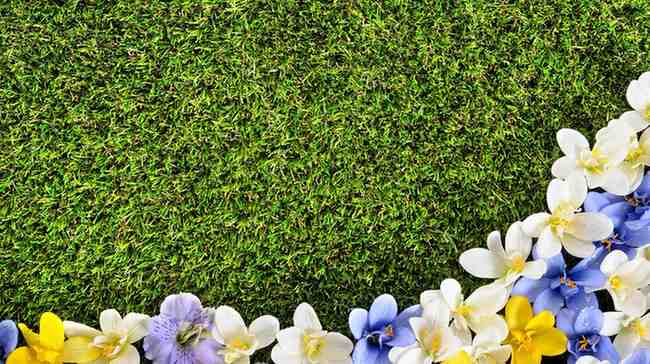Ground cover flowers are low growing plants that spread across the soil to create a colorful, living carpet in your garden. These flowers don’t just enhance the beauty of your landscape, they also serve a practical purpose. By covering bare ground, they help control weeds, reduce soil erosion and retain moisture. Whether you’re filling gaps between stepping stones or looking for a solution for sloped areas, ground cover flowers are a smart and stylish choice.
From creeping sage to phlox and periwinkle, there are many varieties suited for different climates, sunlight levels and soil conditions. What makes them especially popular among gardeners is their low maintenance and ability to thrive where grass or larger plants may struggle. In the sections ahead, we’ll explore the types, benefits, planting tips and much more to help you choose the right ground cover flowers for your space.
Why should you consider using ground cover flowers in your yard?
Ground cover flowers are an excellent landscaping choice because they offer beauty and practicality, covering bare spots, reducing weeds, conserving soil moisture, and adding a low-maintenance burst of color to your yard.
Benefits of Ground Cover Flowers
Ground cover flowers offer more than just a burst of color; they bring multiple practical and ecological benefits to any garden or landscape. One of their primary advantages is weed suppression. By forming a dense mat across the soil, these plants block sunlight from reaching weed seeds, preventing them from germinating and spreading. This means you’ll spend less time pulling weeds and more time enjoying your garden.
Additionally, these flowers help prevent soil erosion especially on slopes or areas prone to runoff. Their spreading roots hold the soil together, reducing the impact of heavy rain or wind. On top of that, they act like a natural mulch, helping the soil retain moisture, which means your garden needs less frequent watering.
Another often overlooked benefit is their low maintenance nature. Once established, many ground cover flowers require minimal care, making them ideal for both busy homeowners and beginner gardeners. Lastly, they provide important habitat and nectar sources for pollinators like bees and butterflies, supporting local biodiversity in a beautiful way.
Popular Varieties of Ground Cover Flowers
When choosing ground cover flowers, it’s important to consider both beauty and function. Fortunately, there are many popular varieties that thrive in a range of environments each offering its own charm and benefits.
One of the most well-loved choices is Creeping Phlox (Phlox subulata). Known for its vibrant spring blooms in shades of pink, purple, white and blue, this hardy plant spreads quickly and forms a dense, flowering carpet. It’s perfect for rock gardens, slopes or borders where you want a splash of color early in the season.
Another standout is Creeping Thyme (Thymus serpyllum). This aromatic herb produces tiny purple or pink flowers in summer and gives off a lovely fragrance when walked on. It thrives in full sun and dry soil, making it ideal for planting between stepping stones or in sunny pathways.
For shade-loving areas, Sweet Woodruff (Galium odoratum) is a favorite. Its small white star-shaped flowers bloom in spring, and the bright green foliage stays lush throughout the season. It’s perfect for under trees or in woodland gardens.
Periwinkle (Vinca minor) is another low-maintenance choice that thrives in shady spots. Its glossy leaves and violet-blue flowers spread steadily, covering large areas with minimal care. It’s especially useful for suppressing weeds in hard-to-reach corners.
Lastly, Lilyturf (Liriope muscari) offers year-round appeal. With grassy foliage, summer flowers, and autumn berries, it handles both sun and shade well. It’s commonly used as a border plant or to fill awkward patches along pathways.
Each of these varieties brings something unique whether it’s seasonal color, ground coverage, or resilience giving you plenty of options to match your garden’s personality and needs.
Choosing the Right Ground Cover for Your Garden
Selecting the best ground cover flowers for your garden isn’t just about picking what looks pretty it’s about matching the right plant to your specific environment and goals. A little planning up front goes a long way in making sure your ground cover thrives and enhances your space for years to come.
Start by observing sunlight exposure in different areas of your garden. Some ground covers, like Creeping Phlox and Creeping Thyme, love full sun and perform best when they get at least six hours of direct sunlight a day. Others, like Sweet Woodruff and Periwinkle, are shade-tolerant and flourish under trees or in spots that receive limited light.
Next, take a look at your soil type and drainage. Most ground covers prefer well-draining soil, but some are more tolerant of dry or sandy conditions, while others prefer moist and rich earth. If your soil is compacted or clay-heavy, consider amending it with compost before planting.
You should also factor in your climate and zone. Not all ground cover flowers are cold-hardy or heat-resistant, so it’s smart to check which USDA plant hardiness zone your area falls into. This ensures your chosen plants will survive and thrive year-round.
Don’t forget your garden’s layout and function. If you want something decorative for a small border, a low-growing, flowering type might be ideal. For larger areas or erosion control on slopes, look for aggressive spreaders like Vinca or Liriope. And if you’re designing a pathway or stepping stone area, a fragrant and foot-tolerant option like Creeping Thyme adds both beauty and practicality.
By carefully considering these factors light, soil, climate, and purpose you can confidently select the right ground cover flowers that not only suit your garden’s style but also grow with ease and minimal maintenance.
Ground Cover Flowers for Different Climates
Every climate comes with its own gardening challenges and that’s especially true when it comes to ground cover flowers. Fortunately, there are beautiful and hardy options for almost every environment, whether you’re dealing with scorching sun, salty air, chilly winters, or high humidity. By choosing flowers that are naturally adapted to your region, you’ll save yourself time, money, and effort on upkeep.
In hot and dry climates, such as the Southwest, ground cover flowers need to tolerate drought and intense sun. Sedum, also known as stonecrop, is an excellent choice. It stores water in its leaves and spreads easily, covering the ground with colorful, fleshy foliage and clusters of blooms. Creeping Thyme also thrives in full sun and poor soil, making it both resilient and aromatic ideal for xeriscaping.
For cooler and temperate zones, like the Northeast or parts of Europe, you’ll want cold-hardy ground covers that can withstand frost and shorter growing seasons. Ajuga (Bugleweed) and Creeping Jenny perform well in these areas. They spread quickly, offer vibrant colors, and remain attractive even when temperatures drop.
In humid or tropical climates, such as the Southeast or coastal regions, you’ll need varieties that resist rot and can handle high moisture. Liriope (monkey grass) and Mondo grass are fantastic options they’re durable, evergreen and do well in both sun and partial shade. Periwinkle (Vinca minor) also stands out with its glossy leaves and violet-blue flowers, thriving in warmth and humidity.
For coastal or saline areas, salt-tolerant plants like Sea Thrift or Ice Plant are best suited. They handle salt spray and sandy soils with ease, adding cheerful color to coastal gardens while protecting the soil from erosion.
Whether you’re battling heat, cold, moisture, or salt, there’s a ground cover flower that’s built for your conditions. Matching the right plant to your climate ensures a low-maintenance and long-lasting garden that looks great year-round.
Combining Ground Covers with Other Plants
One of the best things about ground cover flowers is how well they work with other plants to create a layered, visually appealing garden. When used thoughtfully, ground covers don’t just fill empty spaces they elevate the entire design, reduce weed competition, and help retain moisture around your other plants. By blending ground covers with shrubs, perennials, or even trees, you create a living tapestry that looks intentional and feels alive.
Start by considering height and structure. Ground cover flowers, being low-growing, work beautifully at the base of taller plants. For example, placing Creeping Jenny or Sweet Alyssum beneath rose bushes softens the look and helps keep the soil cool. Similarly, mixing Ajuga with ornamental grasses or daylilies adds a pop of color beneath swaying verticals.
Next, think about color and seasonal interest. Choose ground covers that contrast or complement the bloom times and hues of your main garden plants. Creeping Phlox offers vibrant early spring color that pairs well with mid-spring tulips or daffodils. Meanwhile, Lamium provides silvery foliage that lights up shady spots beneath hydrangeas or hostas.
Don’t forget about texture. Blending fine, delicate flowers like Baby’s Tears with bolder-leafed plants such as hostas or ferns adds depth and keeps the garden from looking flat. This kind of variety also attracts beneficial insects and supports biodiversity.
In vegetable or herb gardens, ground covers like Thyme, Oregano, or even Nasturtium offer a functional and edible pairing. These not only suppress weeds but also deter certain pests and attract pollinators, making them excellent companion plants.
Ultimately, combining ground covers with other plants isn’t just about aesthetics it’s about creating a resilient, healthy garden ecosystem. With the right choices, your ground covers will work in harmony with other plants.
Common Mistakes to Avoid
While ground cover flowers are generally low-maintenance and rewarding, several common mistakes can limit their success or even cause long-term issues in your garden. Fortunately, by understanding these missteps early, you can make smarter choices and create a healthier, more attractive space.
1. Ignoring Growth Habits
One of the most frequent mistakes is underestimating how aggressively some ground covers spread. Plants like English Ivy or Mint can quickly take over garden beds and even invade unwanted areas if not properly controlled. Always check whether the variety you’re planting is considered invasive in your region and plan accordingly.
2. Planting Without Considering Sunlight Needs
Not all ground covers thrive in the same conditions. A shade-loving plant like Pachysandra won’t perform well in direct sunlight, just as Creeping Thyme may struggle in full shade. Before planting, evaluate the light exposure of each area in your garden and choose plants that match those conditions.
3. Poor Soil Preparation
Skipping soil preparation can lead to stunted growth or root diseases. Just like any other plant, ground covers need well-draining, fertile soil to thrive. Take time to clear weeds, loosen compacted areas, and amend the soil with compost or organic matter where needed.
4. Overcrowding Plants
It’s tempting to plant ground covers close together to achieve full coverage quickly, but overcrowding can actually backfire. Dense spacing may reduce airflow and increase the risk of fungal problems. Follow spacing recommendations for each plant type even if it takes a little longer for full coverage to develop.
5. Neglecting Maintenance
Even low-maintenance ground covers need some care. Neglecting to trim back overgrowth, remove dead patches, or water during dry spells can cause these plants to decline over time. Occasional pruning and seasonal cleanups help keep ground covers healthy and vibrant.
6. Not Considering Compatibility
Finally, planting ground covers without thinking about how they interact with other plants in your garden can create conflict. Some varieties compete aggressively for nutrients or water. Be sure to pair ground covers with plants that can coexist peacefully.
By avoiding these common pitfalls, you’ll give your ground cover flowers the best possible environment to grow, spread, and enhance your garden for years to come.
Final Thoughts
Ground cover flowers may be low to the ground, but their impact is sky-high when it comes to beautifying your outdoor space. These magical blooms not only fill in empty patches with vibrant colors and lush greenery, but they also help with weed control, soil retention, and moisture balance. Whether you choose Creeping Thyme, Sedum, or Periwinkle, ground cover flowers can completely transform a dull yard into a blooming paradise.
Incorporating ground covers into your landscaping brings a touch of effortless magic, creating a carpet of color and texture that requires minimal maintenance but delivers maximum charm. It’s a simple yet powerful way to make your yard feel more alive, cohesive, and enchanting all year long.
Frequently Asked Questions (FAQs)
What are the best ground cover flowers for full sun?
Great options include Creeping Phlox, Sedum, Ice Plant, and Creeping Thyme, all of which thrive in sunny areas and bloom beautifully.
2. Are ground cover flowers easy to maintain?
Yes! Most ground cover flowers are low-maintenance, needing only basic watering and occasional trimming to keep them neat and healthy.
3. Can ground cover flowers prevent weeds?
Absolutely. Dense-growing ground covers create a natural barrier against weeds, reducing the need for chemical weed control.
4. What’s the fastest-growing ground cover flower?
Creeping Jenny, Periwinkle, and Ajuga are among the fastest-spreading varieties that quickly fill up space.
5. Do ground cover flowers survive winter?
Some are evergreen and winter-hardy, like Periwinkle and Ajuga, while others may go dormant and return in the spring.
6. Can I use ground cover flowers on slopes or hills?
Yes! Ground covers are ideal for preventing erosion and adding beauty to slopes or uneven terrain.
7. How do I plant ground cover flowers?
Prepare the soil by removing weeds, add compost if needed, then plant your ground cover seedlings or cuttings a few inches apart to allow them to spread naturally.



